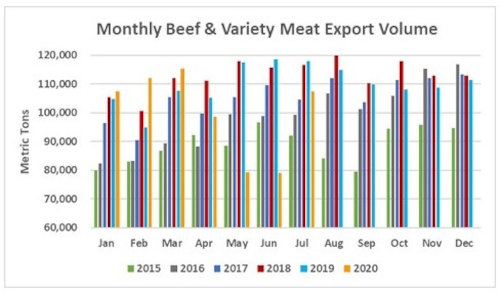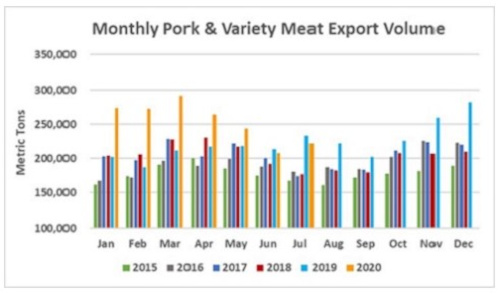July exports of U.S. beef rebounded from recent lows but remained below 2019 levels, according to data released by USDA and compiled by the U.S. Meat Export Federation (USMEF). U.S. pork exports, which are on a record pace in 2020, were also down from a year ago in July but increased compared to June. July lamb exports increased year-over-year and were the largest of 2020.
“With production returning to near-normal levels, we definitely saw an improvement in beef exports, though the recovery was not quite as strong as expected,” said USMEF President and CEO Dan Halstrom. “China’s pork demand has moderated and we are also entering a time when year-over-year gains are not nearly as dramatic, as exports to China began gaining momentum in mid-2019. But pork exports to Mexico showed encouraging signs of recovery in July and we also saw promising growth in several emerging markets, including Vietnam and the Philippines.
“It is also important to remember that the monthly export data is in the rear-view mirror and that weekly export sales data, along with observations from our USMEF-China team, suggest that China’s demand for both U.S. pork and beef will be strong through the balance of the year, including purchases for Chinese New Year. When combined with the rebound in other main markets, growth in emerging markets and the return of the U.S. supply advantage, USMEF remains optimistic about a strong finish for U.S. red meat exports in 2020, despite many challenges related to COVID-19.”
July beef exports totaled 107,298 metric tons (mt), up 36% from June but still 9% below last year. Export value was $647.8 million, the highest since March but down 10% from a year ago. July exports to China increased sharply year-over-year and shipments trended higher to Taiwan, Canada and Hong Kong. July exports were lower than a year ago to Japan and South Korea and declined significantly to Mexico. For January through July, beef exports were also 9% below last year’s pace in volume (698,907 mt) and 10% lower in value ($4.28 billion).
Beef export value per head of fed slaughter averaged $280.40 in July, down 9% from a year ago. The January-July average was $297.21 per head, down 5%. Exports accounted for 12.9% of total July beef production and 10.8% for muscle cuts, compared to 14.4% and 11.8%, respectively, in July 2019. For January through July, exports accounted for 13.2% of total production and 10.9% muscle cuts, down from 14.2% and 11.6% a year ago.
July pork exports totaled 222,035 mt, down 5% from a year ago, while export value fell 12% to $548.3 million. Exports increased year-over-year to China/Hong Kong, Canada, the Philippines, Vietnam and the Caribbean. Exports to Mexico remained below last year but were the largest since March, while shipments to Japan were also down from a year ago but the largest since April. For January through July, pork exports remained 20% ahead of last year’s record pace in volume (1.78 million mt) and 22% higher in value ($4.6 billion).
Pork export value equated to $48.85 per head in July, down 17% from a year ago. The January-July average was $61.40, up 20%. July pork exports accounted for 26% of total pork production and 24% for muscle cuts, compared to 29.3% and 25.9%, respectively, a year ago. Through July, pork exports accounted for 30.7% of total production and 27.9% for muscle cuts, still up significantly from a year ago (26.3% and 22.9%, respectively).
Beef exports to China continue to grow; other Asian markets show signs of recovery
Since its March implementation, the U.S.-China Phase One Economic and Trade Agreement has sparked growth in China’s demand for U.S. beef. July exports were record-large at 2,350 mt, up 160% from a year ago, valued at $14.9 million (up 92%). Through July, exports were 95% above last year’s pace in volume (9,262 mt) and 82% higher in value ($68.9 million).
Beef exports to Hong Kong also increased in July, reaching 7,179 mt (up 19% from a year ago) valued at $53.1 million (up 4%). Through July, exports to Hong Kong remained 7% below last year at 45,175 mt, with value down 10% to $371.4 million.
July exports to Taiwan, where U.S. beef exports have set seven consecutive annual value records, exceeded last year by 10% at 5,989 mt, with value steady at $48.2 million. Through July, exports were 4% below last year’s pace in volume (35,090 mt) and 7% lower in value ($300.4 million).
“Although there is still a long recovery ahead, the foodservice sectors in Taiwan, Hong Kong and China have rebounded more quickly than most other regions,” Halstrom said. “Phase One has also helped spark importer interest in the Chinese market, where U.S. beef is really just beginning to gain traction. There is unmet demand for high-quality, grain-fed beef in China, especially with Australian supplies tightening, and buyers are anxious to secure U.S. beef.”
Other January-July highlights for U.S. beef include:
- Exports to leading market Japan were 3% below last year’s pace at 183,420 mt, with value down 2% to $1.17 billion. But U.S. beef continues to recapture market share in Japan, climbing from 41% last year to 43% in 2020 – surpassing Australia as the top supplier. U.S. prices for July exports were sharply higher than last year, especially for variety meats and chilled cuts, suggesting that while it takes time to adjust to earlier supply interruptions, continued normalization in prices will help exports regain momentum.
- Although July exports to Korea recovered to near-2019 levels, January-July exports were 7% below last year’s record pace at 141,113 mt, valued at $997.2 million. U.S. beef is also gaining market share in Korea at the expense of Australia, with U.S. share through July reaching 51.5%, up from 49% last year.
- Canada continues to be a bright spot for U.S. beef in 2020, with exports up 13% from a year ago to 64,677 mt, valued at $436.4 million (up 14%). Beef variety meat exports to Canada have been particularly strong, climbing 33% from a year ago to 5,675 mt, valued at $12.2 million (up 52%).
- With beef consumption in Mexico being especially dependent on the foodservice and hospitality sectors, COVID-19 restrictions have hit exports hard in 2020. Beef is by far the most expensive protein in Mexico and demand has been negatively impacted by the economic slowdown. Through July, exports were 26% below last year in volume (100,230 mt) and 30% lower in value ($433.4 million). Variety meat exports have been less heavily impacted, falling 4% to 50,204 mt, valued at $123.3 million (down 11%).


Strong growth for U.S. pork in ASEAN region; exports to Mexico show rebound
China/Hong Kong remained the leading destination for U.S. pork exports in July at 71,853 mt, up 5% from a year ago but the lowest since October. Export value was down slightly from a year ago to $151.1 million. Through July, exports to the region were 131% above last year’s pace at 676,009 mt, with value up 171% to $1.57 billion.
The ASEAN region continued to shine for U.S. pork in July, with the Philippines joining Vietnam in a strong upward trend in demand. July exports to the Philippines climbed 90% higher than a year ago to 4,640 mt, with value soaring 141% to $11.8 million. Through July, exports to the Philippines pulled even with last year in volume (21,735 mt) and were 8% higher in value ($54.3 million). July muscle cut exports to Vietnam set a new record of 2,443 mt valued at $5.3 million. Total exports to Vietnam were the largest in more than 10 years at 2,923 mt, up 278% from a year ago, with value up 552% to $6.3 million. This pushed January-July exports to 11,155 mt (up 173%) valued at $24.2 million (up 212%). Region-wide exports to the ASEAN were 25% above last year in volume (36,736 mt) and 31% higher in value ($89.9 million).
“The impact of African swine fever in the ASEAN region has been somewhat overshadowed by the situation in China, but several countries are struggling with the disease,” Halstrom said. “The increase in demand for imported pork surfaced most quickly in Vietnam, but growth opportunities are emerging throughout Southeast Asia.”
While July pork exports to Mexico remained well below last year at 56,185 mt (down 16%), valued at $81.1 million (down 36%), shipments were up significantly compared to the low totals reported in May and June. Through July, exports to Mexico were 8% below last year’s pace at 380,666 mt, with value down 11% to $624.2 million.
Other January-July highlights for U.S. pork include:
- July exports to Japan, traditionally the leading value market for U.S. pork, were down 6% from a year ago to 29,293 mt, valued at $128.6 million (down 3%). Through July, export volume to Japan was steady with last year at 223,115 mt and value remained 4% higher at $942.3 million. The impact of limited labor availability on U.S. exports is pronounced in Japan, where value-added cuts are demanded for the chilled retail business.
- After slowing in the second quarter, pork exports to Canada rebounded in July to pull 2% ahead of last year’s pace in both volume (126,172 mt) and value $463.6 million.
Click here to see more...